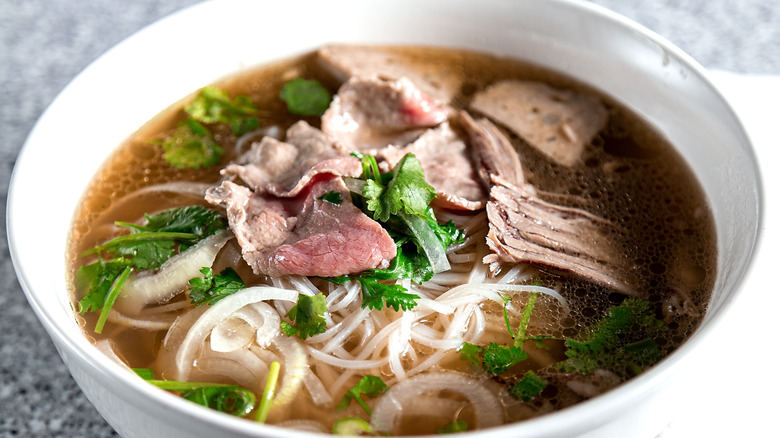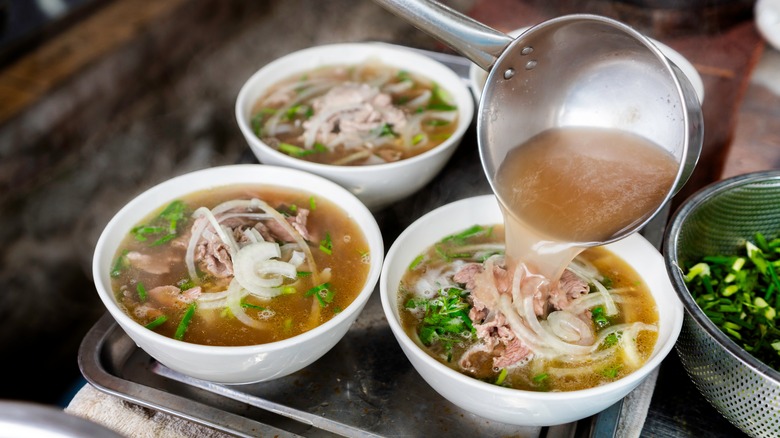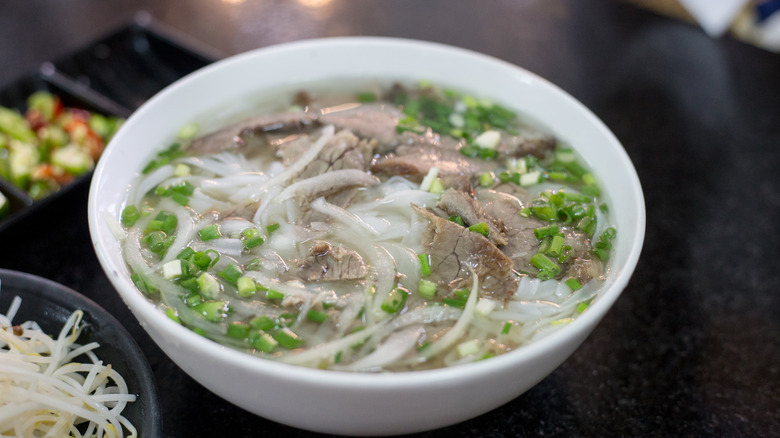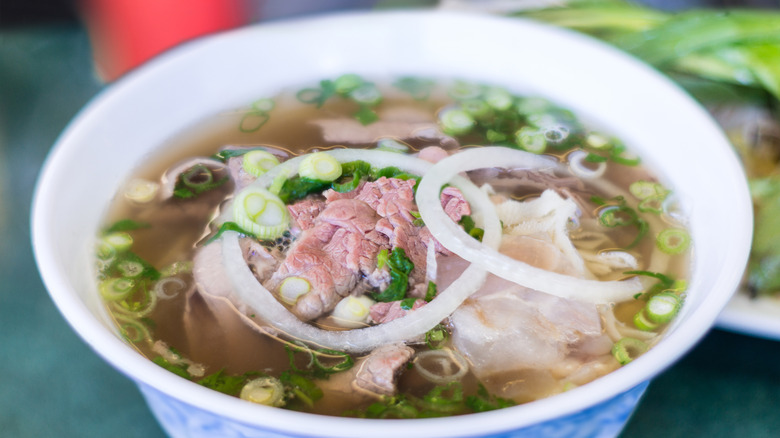The Absolute Best Beef Cuts For Rich, Savory Pho
Pho is arguably the crown jewel of Vietnamese cuisine. Warm and wholesome, this soupy noodle dish (which is different from ramen) can be found at just about every Vietnamese restaurant and has been the go-to breakfast for Vietnamese and many others around the world for decades. While the rich bone broth and flat rice noodles are both essential components of a well-made bowl of pho, for many, the true star is the thinly sliced beef. To achieve the perfect texture and flavor, the meat should be tender but not overly marbled, which means that not just any cut will do.
Vietnamese chefs use a variety of beef cuts for their pho, depending on availability and the specific version they're preparing. However, some of the most popular choices are typically shank, flank steak, brisket, and tenderloin. If you know your meat, you'll notice that most of these are on the lean side. Leaner cuts of beef are often preferred because they don't overwhelm your palate with fat when you take a bite. While a little marbling is desirable for tenderness, the recurring theme for pho is the leaner the cut, the better the final dish will come out.
Go for leaner cuts if you're making pho with raw beef
Rare beef pho (phở tái) is a version of the dish where the beef slices are left uncooked and layered directly on top of the noodles. A few minutes before it's served, a cascade of steaming, near-boiling broth is poured over the beef. By the time you pick up your chopsticks, the meat will already be perfectly cooked. This is how it achieves the juiciness and tenderness that is associated with this variation of pho.
If this is the type of pho you're planning to make, then lean, tender, and quick-cooking cuts are the way to go. Loin cuts, such as short loin, sirloin, and tenderloin, are all excellent for the job, as is flank steak. Another favorite is eye of round, a tough cut which, per its name, makes up the core of the round section. For the best results, partially freeze the beef before slicing it as thinly as possible. Thinner cuts will cook through more quickly once you pour in the hot broth.
Brisket is the ultimate cut for well-done pho
For those who prefer their beef fully cooked through, try well-done pho, or phở chín. This version of the Vietnamese noodle soup is the same as raw beef pho, only the slices of meat are parboiled and cooked long before they're added to the dish. Many people think this takes away the classic pho-tasting experience, but eat what makes you the most comfortable. (Plus, lots of Vietnamese eat this way, too.)
Brisket is the way to go for this type of pho. This cut comes from a part of the animal that is under a great deal of physical strain, so the meat is notoriously tough. While that makes it less than ideal for raw beef pho, it's perfect for the well-done kind because of how the muscle fibers break down as everything cooks.
For well-done pho, brisket is added to the pot while the bone broth bubbles away – a process that can take several hours to complete, though the meat only needs to simmer away in the broth for about an hour to 90 minutes. That's still ample time for its texture to turn from tough to tender. Once cooked through, the meat can be sliced thinly and set aside until it's time to place the beef on top of the noodles.
Beef tendon is the cut you need for a chewy pho
Though they're not as common in the United States, if you can source some beef tendons, they'll make for a wonderful type of pho called, aptly, tendon pho (phở gân). Tendons are connective tissues that keep the cattle's muscles and bones bound together. Raw tendons have a pinkish-white color and a strong beefy smell, plus a texture that's similar to rubber bands (avoid yellowed or awful-smelling tendons, those aren't fresh.) They may not look like such great cuts of beef then, but when properly cooked, you'll know just why they're so beloved in Vietnam and beyond.
Similar to brisket, the tendons are cooked along with the broth, though they only need to be boiled for about 20 minutes to soften them up. Once cooked, they're removed from the broth and immediately plunged into ice water. This blanching step helps them develop a pleasantly chewy texture. Cooks who prefer tenderer tendons, however, may let them simmer for up to four hours.
The tendon is served just like any other pho topping: When you're assembling the noodle soup, you lay the slices over the rice noodles before ladling the hot broth. With a smattering of green onions and some aromatic herbs, you'll have a unique tasting experience. Other chewy, beefy cuts can complement your tendons, including tripe and beef balls, favorites of chef Tu David Phu, who shared his love for the dish and its "painfully beautiful story" on Instagram.



